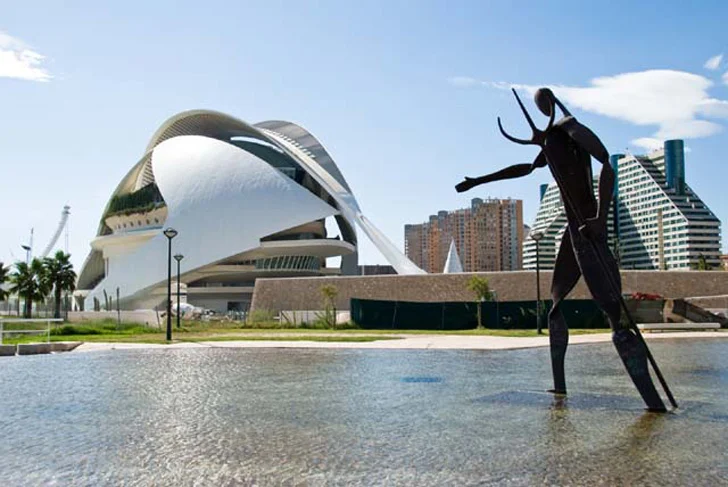
By James Martin
Europe Travel Expert, about.com
Valencia is located on Spain's eastern Mediterranean
coast, on the Gulf of Valencia at the mouth of the Turia river. To the
north lies Cataluna and the popular destinations of Barcelona and
Tarragona, to the west Castilla-La Mancha and to the south the region of
Murcia separates Valencia from Andalusia.Throughout
history, Valencia was one of the most important sea ports of the
Iberian peninsula. Valencia is 350 km from either Madrid to the west or
Barcelona, to the north.
[post_ads_2]
Valencia's population is estimated at
around 790,000 people. It is Spain's third largest city, but its central
core is intimate and very manageable for the tourist.
Languages
Residents of Valencia speak Spanish, of course, but you'll also hear "Valenciano" when you're touring the neighborhoods.
Valencia Train Stations:
The Norte
Railway Station of Valencia is located in the heart of Valencia. Daily
connections to Madrid, Barcelona, Sevilla, Alicante, Port Bou (French
border), Zaragoza, Bilbao and trains to other provinces leave from here.
For more information and train schedules see RENFE, the Spanish Railway Service.
Historic Climate and Weather
Valencia
is dominated by a Mediterranean climate, meaning there are warm and dry
summers with relatively mild winters. The rainy season comes primarily
in spring and fall, when there are occasional torrential rainfalls. The
average July and August temperatures are 25 degrees Centigrade. For a
Valencia climate charts and current weather, see Valencia, Spain Travel Weather.
Las Fallas - Valencia's Most Famous Festival
Las Fallas
is a festival held from March 12th to March 19th. What are Las Fallas?
Huge papier-mache art sculptures are erected on almost every square.
Usually there are around 300 of these, and most are indicative of social
criticism and sarcasm. Then, on March 19th the Fallas are
simultaneously burned at midnight in a ritual called "la nit del foc"
[post_ads_2]
Damian Corrigan has extensive coverage of Las Fallas, with recommendations on what to do and see and where to stay.
The Covered Market
Fans of covered markets will want to head over to Valencia's huge central market, al Mercado Central de Valencia,
for a fix. You'll find 8000 square meters of market space inside the
steel and glass building decorated with Valencia ceramic tiles. Nearby
is the Llotja de a Seda, the Silk Exchange, in Placa del Mercat--a testament to Valencia's lofty position in the silk trade.
Shopping & Handicrafts
What
to look for in Valencia markets? Ceramics is one of the big hits, and
anything crafted in wood or vegetable fibers is a good bet, as Valencia
is in a very green zone. Rice is one of the big foodstuffs tourists
might buy if they don't mind lugging a few kilos of rice around Europe
for that next big paella.
Cuisine
The cuisine of Valencia
is based around the region's high quality rice. What you eat with it
depends upon where you are; near the sea you eat seafood, in the
mountain side you eat game, lamb and kid. The most internationally
famous dish is, of course, Paella. To find out more about Valencia's regional cuisine.
City of Arts and Sciences, Valencia, Spain
The 87-acre site contains Hemispheric, housing a planetarium and imax theater, the Trojan helmet like Palau de les Artes and the hands-on Prince Felipe Museum of the Sciences (Museu de les Ciències Príncipe Felipe), where you are encouraged to build and discover elements of science. There's also L'Oceanogràfic,
called the largest aquarium in Europe, housing species in pavilions
named after their home oceans and seas. A covered garden view promenade
called Umbracle brings it all together.
The Top Attractions
Valencia is a city of art and history. There are lots of museums to visit. Here is a list of the most frequented:
- Bulfight Art Museum - right by the train station at C. Dr. Serra 16, the first museum in the world devoted to bullfighting.
- El Museo de Bellas Artas de Valencia - The fine arts museum is second only to Madrid's Prado. Lots of works from Valencia's golden age around the 15th century.
- Museum of Science "Principe Felipe" at 5 Avenida Autopista de El Saler 46013, an interactive museum inside the City of Arts and Science with exhibitions about science and technology.
- Valencian Institute of Modern Art - One of the best modern museums in Spain--plus the ancient walls cut right through it.
For other interesting museums, see Museums in Valencia.
Valencia's Botanic Gardens, Jardi Botanic, are the oldest in the city and one of the more interesting in Europe, containing over 40,000 plants.
Valencia's Cathedral
was started in the 13th century, finished in the 15th. Although
primarily gothic, it contains a mix of styles reflecting aspects of
Romanesque, Gothic and baroque construction. There are guided tours from
4-7pm for a small charge. The Cathedral Museum, Museu de la Seo, is a little museum chock full of amazing treasures collected by the church.
[post_ads_2]
Find more interesting Valencia attractions see Valencia top ten tourist attractions.
Nighlife - Bohemians head over to the Barrio del Carmen,
the "real" old town of Valencia with winding and narrow streets, the
houses now teeming with restaurants, bars and clubs. In the summer the
action moves over to the pubs and hangouts in the beach zone, along the
Neptuno Avenue. Folks head out around 11, or earlier if tapas is
required before your long night out. This is Spain, so you can't eat
earlier than 9 or so unless it's tapas.

























